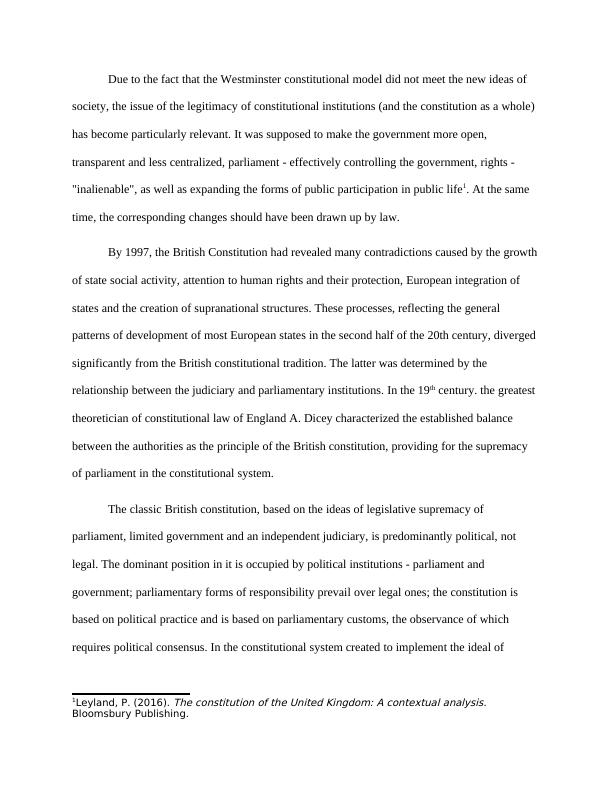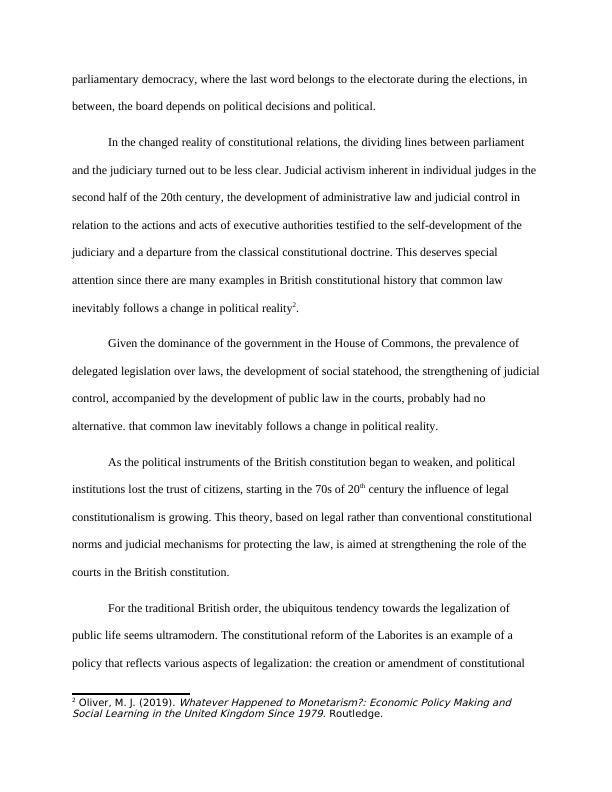Separation of Powers in British Constitution
Added on 2022-09-05
8 Pages1938 Words41 Views
Separation of Powers in British Constitution
Student’s Name
Institution
Date
Student’s Name
Institution
Date

Due to the fact that the Westminster constitutional model did not meet the new ideas of
society, the issue of the legitimacy of constitutional institutions (and the constitution as a whole)
has become particularly relevant. It was supposed to make the government more open,
transparent and less centralized, parliament - effectively controlling the government, rights -
"inalienable", as well as expanding the forms of public participation in public life1. At the same
time, the corresponding changes should have been drawn up by law.
By 1997, the British Constitution had revealed many contradictions caused by the growth
of state social activity, attention to human rights and their protection, European integration of
states and the creation of supranational structures. These processes, reflecting the general
patterns of development of most European states in the second half of the 20th century, diverged
significantly from the British constitutional tradition. The latter was determined by the
relationship between the judiciary and parliamentary institutions. In the 19th century. the greatest
theoretician of constitutional law of England A. Dicey characterized the established balance
between the authorities as the principle of the British constitution, providing for the supremacy
of parliament in the constitutional system.
The classic British constitution, based on the ideas of legislative supremacy of
parliament, limited government and an independent judiciary, is predominantly political, not
legal. The dominant position in it is occupied by political institutions - parliament and
government; parliamentary forms of responsibility prevail over legal ones; the constitution is
based on political practice and is based on parliamentary customs, the observance of which
requires political consensus. In the constitutional system created to implement the ideal of
1Leyland, P. (2016).
The constitution of the United Kingdom: A contextual analysis.
Bloomsbury Publishing.
society, the issue of the legitimacy of constitutional institutions (and the constitution as a whole)
has become particularly relevant. It was supposed to make the government more open,
transparent and less centralized, parliament - effectively controlling the government, rights -
"inalienable", as well as expanding the forms of public participation in public life1. At the same
time, the corresponding changes should have been drawn up by law.
By 1997, the British Constitution had revealed many contradictions caused by the growth
of state social activity, attention to human rights and their protection, European integration of
states and the creation of supranational structures. These processes, reflecting the general
patterns of development of most European states in the second half of the 20th century, diverged
significantly from the British constitutional tradition. The latter was determined by the
relationship between the judiciary and parliamentary institutions. In the 19th century. the greatest
theoretician of constitutional law of England A. Dicey characterized the established balance
between the authorities as the principle of the British constitution, providing for the supremacy
of parliament in the constitutional system.
The classic British constitution, based on the ideas of legislative supremacy of
parliament, limited government and an independent judiciary, is predominantly political, not
legal. The dominant position in it is occupied by political institutions - parliament and
government; parliamentary forms of responsibility prevail over legal ones; the constitution is
based on political practice and is based on parliamentary customs, the observance of which
requires political consensus. In the constitutional system created to implement the ideal of
1Leyland, P. (2016).
The constitution of the United Kingdom: A contextual analysis.
Bloomsbury Publishing.

parliamentary democracy, where the last word belongs to the electorate during the elections, in
between, the board depends on political decisions and political.
In the changed reality of constitutional relations, the dividing lines between parliament
and the judiciary turned out to be less clear. Judicial activism inherent in individual judges in the
second half of the 20th century, the development of administrative law and judicial control in
relation to the actions and acts of executive authorities testified to the self-development of the
judiciary and a departure from the classical constitutional doctrine. This deserves special
attention since there are many examples in British constitutional history that common law
inevitably follows a change in political reality2.
Given the dominance of the government in the House of Commons, the prevalence of
delegated legislation over laws, the development of social statehood, the strengthening of judicial
control, accompanied by the development of public law in the courts, probably had no
alternative. that common law inevitably follows a change in political reality.
As the political instruments of the British constitution began to weaken, and political
institutions lost the trust of citizens, starting in the 70s of 20th century the influence of legal
constitutionalism is growing. This theory, based on legal rather than conventional constitutional
norms and judicial mechanisms for protecting the law, is aimed at strengthening the role of the
courts in the British constitution.
For the traditional British order, the ubiquitous tendency towards the legalization of
public life seems ultramodern. The constitutional reform of the Laborites is an example of a
policy that reflects various aspects of legalization: the creation or amendment of constitutional
2 Oliver, M. J. (2019).
Whatever Happened to Monetarism?: Economic Policy Making and
Social Learning in the United Kingdom Since 1979. Routledge.
between, the board depends on political decisions and political.
In the changed reality of constitutional relations, the dividing lines between parliament
and the judiciary turned out to be less clear. Judicial activism inherent in individual judges in the
second half of the 20th century, the development of administrative law and judicial control in
relation to the actions and acts of executive authorities testified to the self-development of the
judiciary and a departure from the classical constitutional doctrine. This deserves special
attention since there are many examples in British constitutional history that common law
inevitably follows a change in political reality2.
Given the dominance of the government in the House of Commons, the prevalence of
delegated legislation over laws, the development of social statehood, the strengthening of judicial
control, accompanied by the development of public law in the courts, probably had no
alternative. that common law inevitably follows a change in political reality.
As the political instruments of the British constitution began to weaken, and political
institutions lost the trust of citizens, starting in the 70s of 20th century the influence of legal
constitutionalism is growing. This theory, based on legal rather than conventional constitutional
norms and judicial mechanisms for protecting the law, is aimed at strengthening the role of the
courts in the British constitution.
For the traditional British order, the ubiquitous tendency towards the legalization of
public life seems ultramodern. The constitutional reform of the Laborites is an example of a
policy that reflects various aspects of legalization: the creation or amendment of constitutional
2 Oliver, M. J. (2019).
Whatever Happened to Monetarism?: Economic Policy Making and
Social Learning in the United Kingdom Since 1979. Routledge.

End of preview
Want to access all the pages? Upload your documents or become a member.
Related Documents
The British Constitutional Order: Fusion of Power or Separation of Power?lg...
|8
|2280
|60
Parliamentary Supremacy Canada 2022lg...
|2
|551
|23
English Legal System: Sources of Lawlg...
|21
|1295
|68
Rights and Freedom under United Kingdom Constitutionslg...
|5
|1229
|399
Impact of Brexit on UK: A Comprehensive Analysislg...
|6
|1831
|363
The Keystone of the Constitution: Executive vs Parliamentlg...
|9
|2439
|48
